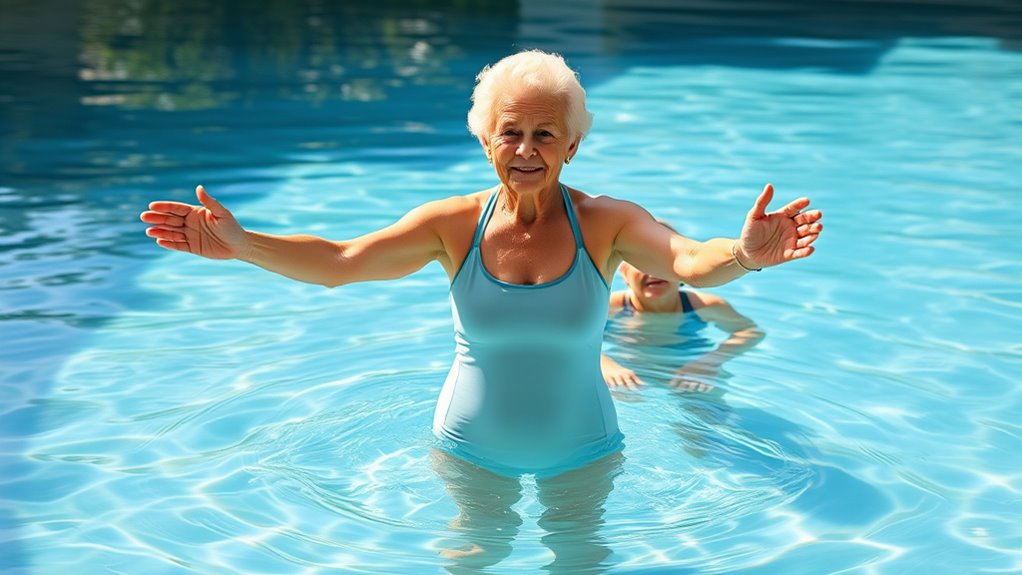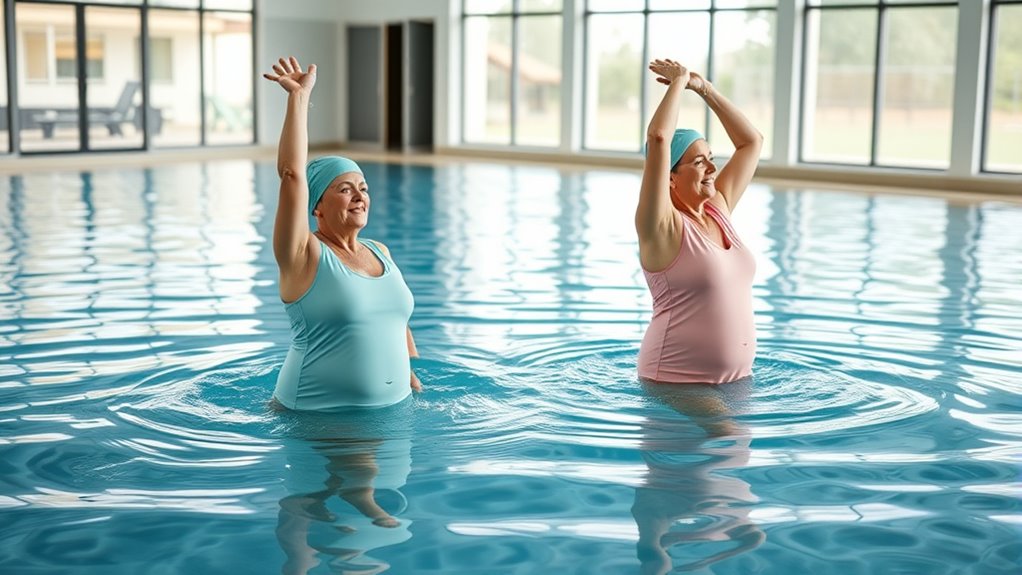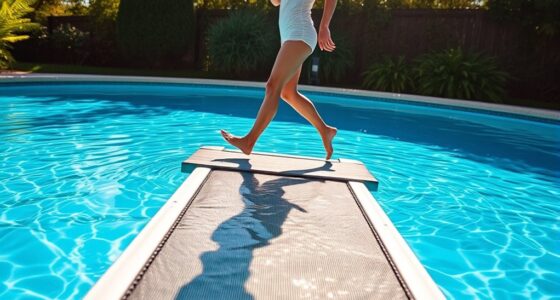To stay fit with less strain, try low-impact pool exercises like water walking, leg lifts, and arm circles. The water’s natural resistance helps build strength while being gentle on your joints, reducing pain and risk of injury. These activities improve your mobility and boost confidence. Because water supports your body, you can exercise comfortably and safely. Keep exploring, and you’ll discover more ways to enjoy these gentle, effective workouts.
Key Takeaways
- Water’s natural resistance enhances muscle engagement while reducing joint stress, making exercises safer and effective for seniors.
- Gentle, low-impact movements like walking, leg lifts, and arm circles improve mobility without overexertion.
- Modifiable routines allow seniors to adjust resistance and intensity, accommodating varying fitness levels and limitations.
- Water support minimizes fall risk and discomfort, encouraging consistent participation in safe, joint-friendly exercises.
- Regular aquatic activity maintains joint flexibility and independence, promoting overall health with less strain.

Exercise is essential for maintaining health as you age, and working out in the pool offers a low-impact way to stay active. The water’s natural resistance makes it an excellent environment for gentle exercise, helping you build strength without putting too much strain on your joints. When you move through the water, you engage muscles more effectively than on land, thanks to water resistance that challenges your muscles with every motion. This resistance isn’t harsh but steady, helping you strengthen muscles gradually while minimizing the risk of injury or overexertion. As you perform simple movements like walking or leg lifts, water resistance provides the perfect amount of challenge to keep your muscles engaged without causing discomfort.
In addition to strengthening, water exercises are great for improving joint mobility. The buoyant nature of water reduces the stress on your joints, especially those affected by arthritis or stiffness. When you’re in the pool, you can move more freely and with less pain, which encourages you to stay active regularly. Gentle activities like arm circles, leg swings, or torso twists can be easily performed in water, helping you maintain or even improve your range of motion. Because the water supports your body, you don’t have to worry about losing balance or risking falls, making it easier to stick with a consistent routine. Incorporating low-impact exercises into your routine can be especially beneficial for maintaining mobility and preventing injury as you age.
One of the best aspects of pool exercises is that they can be adapted to your fitness level. Whether you’re just starting out or looking to increase your activity, you can modify movements to suit your needs. For example, if standing exercises become difficult, you can do seated movements in the water. As your strength and confidence grow, you can add more dynamic motions or increase intensity by moving against the water’s resistance more deliberately. The key is to listen to your body and avoid pushing into pain. Regular, gentle movements in the pool help keep your joints flexible and reduce stiffness, supporting overall mobility and independence.
Frequently Asked Questions
What Safety Precautions Should Seniors Take Before Starting Pool Exercises?
Before starting pool exercises, you should guarantee safety by checking water temperature, keeping it warm enough to prevent muscle strain but not too hot. Also, verify pool depth to stay in shallow areas that allow for easy footing and support. Consult your doctor beforehand, especially if you have health concerns. Make sure to warm up, stay hydrated, and wear appropriate footwear or floatation devices for added stability and safety.
How Often Should Seniors Perform Pool Exercises for Optimal Benefits?
You should aim for exercise frequency of about three to five times a week, allowing your body time to recover. Each session should last 20 to 30 minutes, balancing activity and rest. Consistency is key for reaping benefits like improved strength and flexibility. Listen to your body, start slow, and gradually increase session duration if you feel comfortable. Regular pool exercises help you stay fit with less strain.
Can Beginners With Limited Mobility Participate in Low-Impact Pool Exercises?
You can absolutely participate in low-impact pool exercises if you’re a beginner with limited mobility. Water resistance provides gentle support, making movements easier and safer, while aquatic balance helps improve stability without strain. By starting slowly and focusing on controlled movements, you build strength and confidence. Remember, the water’s buoyancy reduces joint stress, so you can enjoy exercising comfortably and gradually increase your activity level.
Are There Specific Pool Exercises Recommended for Arthritis Relief?
If you’re looking to ease arthritis pain and boost joint flexibility, certain pool exercises can really help. Focus on gentle moves like water walking, arm circles, and leg lifts, which reduce joint stress while promoting mobility. Always start slow and listen to your body. Water’s buoyancy supports your joints, making these exercises effective and safe for managing arthritis symptoms. Consult with a healthcare professional before beginning any new routine.
What Equipment Is Necessary for Low-Impact Pool Workouts?
Think of your pool as a playground, where the right equipment transforms your workout into a fun adventure. You’ll mainly need pool noodles for support and balance, acting like friendly guides through the water. Waterproof shoes keep you steady on slippery surfaces, like sturdy boots on a rocky trail. With these essentials, you’re ready to enjoy gentle, effective exercises that keep you active while protecting your joints.
Conclusion
Remember, a journey of a thousand miles begins with a single step. By incorporating these low-impact pool exercises into your routine, you can stay active and healthy without putting too much strain on your joints. Keep moving at your own pace, and enjoy the many benefits of water exercise. Staying consistent is key—so immerse yourself and make fitness a fun part of your daily life. Your body will thank you for it!









